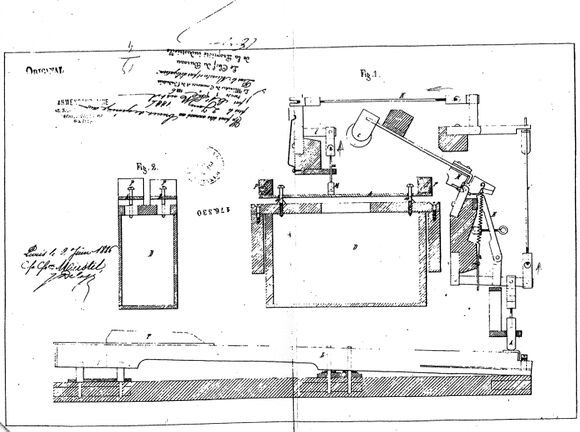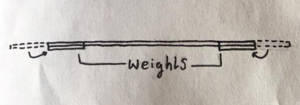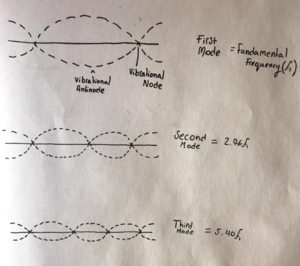Course:Phys341 2020/Celeste
The Celeste
The celeste (/sɪˈlɛst/) or celesta (/sɪˈlɛstə/), is a keyboard operated percussion instrument which resembles an upright piano. Much like the piano, the celeste creates its sound through the use of mallets; however, what differentiates it from the former instrument is that it strikes metal plates as opposed to strings, and the sound is resonated through the use of a series of soundboxes instead of a soundboard.
History

In 1886, a relatively unknown French harmonium maker by the name of Auguste Mustel invented the celeste. To Mustel, the distinctive metallic timbre of the instrument captured the harmony of the heavens, leading him to name the instrument after the stars. Upon its creation, the celeste was not particularly popular, however, this was quick to change; indeed, at some point towards the end of the 1880s, the Russian composer, Pyotr Ilyich Tchaikovsky, while browsing various Parisian antiquarian shops, discovered the celeste. Tchaikovsky was immediately enamoured by the sound it made, and was quick to employ it in his various compositions---most notably, the Dance of the Sugar Plum Fairy. Since Tchaikovsky's discovery of the instrument, many artists ranging from Mahler to The Rolling Stones have employed celestes in various compositions. More recently, it has been enshrined in the musical imagination in the form of the Harry Potter theme song.
Structure
General Characteristics
According to the musical instrument typology established by Hornbostol and Sachs, the celeste can be defined as an idiophone, an instrument which creates sound not by exciting a string or membrane but instead by vibrating a large part of the instrument; in particular, it is defined as a percussion idiophone.[1] In the case of the celeste, the vibrating dimension of the instrument is its metal bars. Mustel's first set of celestes had 49 of these metal bars, giving the instrument a range of four octaves, but more contemporary celestes tend to encompass 5 octaves. To create sound, the top of each bar is struck by a felt-tipped mallet, which in turn lends the instrument its iconic metal timbre. The produced sound is both radiated and filtered by an accompanying soundbox which sits below the bar, although this configuration can differ as, for instance, in Yamaha celestes where the soundboxes sit atop the metal bars which are struck upwards by mallets--like in a piano. Despite more modern configurations, it was the fact that the instrument's mallet falls downwards on the metal bars which Mustel thought was so original and thus patented the design in 1886. Moreover, this downward stroke of the mallets, as well as its incorporation of soundboxes, is what delineates the celeste from one of its closest musical relative, the keyboard glockenspiel.
General mechanism
The sound of the celeste is dependent on the interplay of four key acoustic features: its bars, hammers, resonating cavities, and pedal. Although different companies organise these mechanisms in differing fashions, the first three of these features are absolutely paramount in both establishing the sound of the instrument and its harmony.

Bars
The bars, which define the celeste's metallic timbre, are typically made of steel alloy, rectangular in shape, their width being between 20-30mm and their length variable. Unlike stringed instruments, the fundamental frequency as well as pitch of barred instruments are determined not by the tension in the excited material but the stiffness, thickness, width, and length of it. In the celeste, the higher range of the instrument is provided by a series of shorter, thicker bars (around 2mm in thickness), whereas the lower range is provided by a series of longer, thinner bars (around 2.5mm in thickness).[2] The bars are organised from right to left in ascending frequency, with each bar being attached to the instrument at its two vibration nodes (each vibration node is located at each end, at a distance of 22.4% of the total length of the bar).[3] To conserve space, the lower frequency bars have weights attached to either end of them. The added weights must be of the same mass and volume as the length being cut from the original bar. (fig. 1) When excited each bar produces a series of vibration patterns, or modes; however, none of these modes are perfect interger multiples of the fundamental and are thus inharmonic. (fig. 2) This inharmonicity, inherent within the bars of the celeste, distinguishes it from other idiophones, like marimbas and xylophones which are hollow out so as to form a vibration pattern which creates integer multiples of the fundamental.
Hammers

To produce sound, the celeste excites the bars with the use of felt-tipped mallets, much like in a piano; however, unlike the piano, the shanks of the hammers are of a differing thickness for every bar (as opposed to the piano with its three different types of hammers), a design which affects the energy input into a given bar. Indeed, hammer design, much like bars and resonators, differs based on the frequency range of the bars; thus, the lower frequency, longer bars are typically accompanied by larger hammers with thicker felt-tips than their higher frequency counterpart.[4] Each hammer is positioned so as to strike the centre of the bar, which is the main vibration antinode. Striking this point elicits a series of inharmonic vibrations---a point made clear by the fact that each frequency is not an integer multiple of the fundamental---the first being that of the fundamental frequency; the second, 2.76 times the fundamental; the third, 5.40 times the frequency; etc. (Fig. 2)[5] Indeed, unlike striking a string which resonates a series of harmonic overtones, the celeste and other percussion instruments do not vibrate in integer multiples of the fundamental and thus possess many inharmonic overtones; consequently, to filter out these overtones each bar is coupled to a resonator.
Resonator
As has been mentioned, the celeste's metal bars are not entirely harmonic---the desired fundamental frequency, often being tainted by inharmonic overtones. To work around this issue, a specially tuned resonator is placed atop or below each metal bar. These resonators amplify the fundamental frequency of a given bar while filtering out the many undesired inharmonic partials which naturally occur when exciting metal bars thus providing the celeste with a set of harmonic frequencies. In the celeste, these Helmholtz resonators are tuned to a particular frequency by adjusting the size of their cavities---with the larger cavities corresponding to lower frequencies, and the smaller ones, higher frequencies. The addition of these resonating cavities also means that as well as the vibration modes provided by the steel bars, the celeste also has a single set of air modes. Moreover, as well as tuning out inharmonic partials, each Helmholtz resonator extends the sound of the instrument, giving it a more prolonged, less metallic timbre.
Pedal
The final contributing feature of the instrument is its dampening pedal. The celeste has one pedal, which much like that of a piano, raises or lowers a set of felt pads from the excited membrane. In the celeste's case, each bar has a damper placed over it which is lifted when a key is pressed; however, this mechanism can be overridden through the use of a pedal which lifts all of the dampers off at once, allowing for a longer resonance of all of the excited bars.
Further Reading
https://en.wikipedia.org/wiki/Celesta
https://www.celesta-schiedmayer.de/en/celesta/all-about-the-celesta/
https://newt.phys.unsw.edu.au/jw/Helmholtz.html
- ↑ "Idiophone". Wikipedia. Retrieved 24/03/2020. Check date values in:
|access-date=(help) - ↑ "The Structure of the Celeste". Yamaha.
- ↑ "The Structure of the Celeste". Yamaha.
- ↑ "Celesta Construction". Vienna Symphonic Library.
- ↑ Rossing, Thomas (2007). Springer Handbook of Acoustics. New York: Springer. pp. 649–650. ISBN 978-0-387-30446-5.